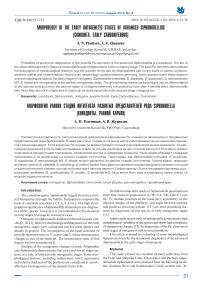Морфология ранних стадий онтогенеза развитых представителей рода Siphonodella (конодонты, ранний карбон)
Автор: Плотицын А.Н., Журавлев А.В.
Журнал: Вестник геонаук @vestnik-geo
Рубрика: Научные статьи
Статья в выпуске: 8 (260), 2016 года.
Бесплатный доступ
Рассмотрена возможность таксономической диагностики ювенильных Pa-элементов эволюционно продвинутых представителей рода Siphonodella. В зависимости от стадии онтогенеза набор наблюдаемых таксономических признаков сильно варьирует. Если взрослые Pa-элементы демонстрируют полный ряд морфологических признаков, то ювенильные формы могут быть диагностированы только на основе некоторых из них: степени изогнутости осевого гребня, очертания и орнаментации платформы, морфологии ростра и симметрии элемента. Часть видов обладают сходными признаками и не различимы на ранних стадиях онтогенеза. Такие виды, как Siphonodella crenulata, S. duplicata, S. quasinuda, S. semichatovae M2, S. lobata, можно различить на ранних стадиях онтогенеза. Группа видов, имеющих длинные гребни ( S. obsoleta, S. sandbergi, S. belkai ), может быть диагностирована на видовом уровне начиная со второй стадии онтогенеза (элемент состоит из более чем 4 пакетов ламелл). Сифоноделлы с более чем двумя короткими ростральными гребнями ( S. quadruplicata, S. cooperi, S. isosticha ) и S. hassi могут быть диагностированы также только со второй стадии онтогенеза.
Конодонты, онтогения, ранний карбон, турнейский ярус, юные формы
Короткий адрес: https://sciup.org/149129216
IDR: 149129216 | УДК: 56.016:551.735 | DOI: 10.19110/2221-1381-2016-8-21-26
Текст научной статьи Морфология ранних стадий онтогенеза развитых представителей рода Siphonodella (конодонты, ранний карбон)
The conodont genus Siphonodella ranged from the terminal Famennian through the middle Tournaisian composes the basis of conodont zonations [3, 5, 6, 8, 9 etc.]. The high stratigraphical significance of siphonodells demands precise diagnostics of the species, however it is not realizable for Pa-elements at early stages of ontogeny in most of cases.
Ontogeny of siphonodells had been reflected in some articles [2, 10, 11], however morphology and diagnostics of the early ontogenetic stages were considered just for some species and mainly in general. The investigation of the basal structure of juvenile representatives of S. cooperi and S. lobata demonstrates changes in size of the basal pit. The taxonomical value of this feature was not considered [2].
Analysis of the ontogenetic changes of some Polygnathus and Siphonodella demonstrates that costa and rostral ridges appear, as a rule, at later juvenile ontogenetic stages. Some morphological features, including rudimentary relief, asymmetry and relative thickness of the platform are considered as a probable basis for diagnostics of the juvenile forms [10].
Detailed ontogenetic study of Siphonodella quadruplicata show that element proportions (L/W=0.4; Lfb/Lpl=0.2 (see fig. 1); median position of the basal pit), asymmetry of the anterior margin of the platform, and angle between anterior and posterior processes (about 153°) are most promising features for diagnostics of this species at early ontogenetic stages [11].
Additionally recent study of siphonodells demonstrates high morphological variability of the species and shows high complexity of ontogenetic changes [13]. So diagnostics of the Pa-elements at early stages of ontogeny is still an actual problem.
This article is aimed to evaluating of some morphological features as a basis for the taxonomic diagnostics of the advanced Siphonodella at the early stages of ontogeny.
Material
This study is based on conodont element collections from the Polar and Subpolar Urals, Chernyshev and Pechora ridges. Abundant siphonodells were obtained from the following localities: Kozhym River and Konstantinov Creek sections (loc. Tz,
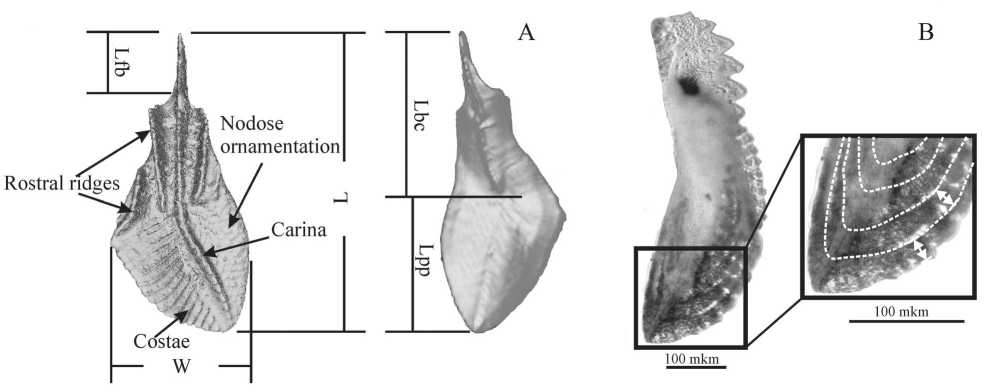
Fig. 1. Morphological terminology of Pa-element of Siphonodella . A — measurements: L — element length; W — platform width; Lfb — length of the free blade; Lbc — length of the anterior process; Lpp — length of the posterior process; B — lamella sets in the platform of the juvenile Pa-element of Siphonodella quadruplicata Branson et Mehl, transmitted light image
Ðèñ. 1. Ìîðôîëîãè÷åñêàÿ òåðìèíîëîãèÿ Pa-ýëåìåíòà Siphonodella . A — èçìåðåíèÿ: L — äëèíà ýëåìåíòà; W — øèðèíà ïëàòôîðìû; Lfb — äëèíà ñâîáîäíîãî ëèñòà; Lbc — äëèíà ïåðåäíåãî îòðîñòêà; Lpp — äëèíà çàäíåãî îòðîñòêà. B — ïàêåòû ëàìåëë â ïëàòôîðìå þâåíèëüíîãî Pa-ýëåìåíòà Siphonodella quadruplicata Branson et Mehl; èçîáðàæåíèå â ïðîõîäÿùåì ñâåòå
Tn) (N 65.685 E 59.77 and N 65.66 E 59.73), Vangyr River section (loc. #W21, #W22) (N 65.1255 E 58.7239), Iz’yayol Creek section (loc. #GER4) (N 65.21 E 58.41), Malaya Usa River section (loc. #mu2, #mu3) (N 67.39 E 65.10), Kamenka River section (loc. #121, #122) (N 65.07 E 56.684).
The late species of the advanced Siphonodella ( S. isosticha (Cooper)) occurs in the Kizel Horizon (isosticha Zone) and represent the youngest material used in this study. The earliest advanced siphonodells comprising S. duplicata (Branson et Mehl), S. semichatovae Kononova et Lipnjagov M2, and S. quasinuda Gagiev, Kononova et Pazukhin occur in the upper part of the Malevka Horizon. The abundant siphonodellids were obtained mainly from the late Tournaisian (quadruplicata Zone) calciturbidites outcropping in the Kozhym River section, Vangyr River section, and Malaya Usa River section.
Total number of the studied specimens is more than 3000. The following species of advanced Siphonodella are well represented in the collections: S. duplicata (Branson et Mehl), S. quasinuda Gagiev, Kononova et Pazuhin, S. semichatovae Kononova et Lipnjagov M2, S. lobata (Branson et Mehl), S. crenulata (Cooper), S. hassi Ji (not S.duplicata sensu Hass, which is junior synonym of S.quadruplicata ), S. obsoleta Hass, S. sandbergi Klapper, S. belkai Dzik, S. quadruplicata (Branson et Mehl), S. cooperi Hass, S. isosticha (Cooper). Siphonodella carinthiaca Schonlauband group of the smooth siphonodells ( S. levis (Ni), S. eurylobata Ji, S. sinensis Ji, S. dasaibaensis Ji, Qin, Zhao) are rare or absent in the collection under investigation, and are not cosidered here.
Methods
Morphology of dextral and sinistral Pa-elements of advanced Siphonodella was studied with SEM (VEGA3 TESCAN of the Institute of Geology Komi SC UrB RAS), X-ray microCT (SkyScan 1272 in the NMSU “Gornyi”) and optic microscopy. Biometric study of Pa-elements of various stages of ontogeny was done as well.
A number of biometric parameters were used: element length, width and length of platform, length of anterior and posterior processes (fig. 1). About 2000 Pa-elements were measured. All the studied species demonstrate isometrical growth of the platform possessing minor changes of proportions in ontogeny (fig. 2, A). The biometric parameters studied demonstrate minor dependence on species, especially at the early stages of ontogeny (see also [10]).
The size of posterior process and the number of lamellae sets are considered as marks of individual age of the element [10] (fig. 2, B). Series of lamellae composed of the lamellar tissue and separated by lamella of interlamellar tissue are considered as lamellae sets. Boundary between the lamellar and inter-lamellar tissues is suggested as surface of arrested growth [12]. Probably each the lamellae set corresponds to a season growth period.
A number of conventional ontogenetic stages were recognized on the basis of structural changes in the element morphology (appearance of the platform ornamentation, rostrum) (fig. 2, B). The first stage comprises Pa-elements composed of less than 3 lamellae sets and having no rostral ridges and any platform ornamentation. The elements of the second stage are composed of 3–5 lamellae sets and possess rostral ridges and outer platform ornamentation (transverse ribbing). The third stage is characterised by more than 5 lamellae sets and demonstrates full set of the ornamentation of the platform. The first two stages are considered as juvenile.
All the advanced siphonodells bear the rostrum in the anterior part of the platform of Pa-element. A number of rostral ridges of various length and orientation are characteristic for the species [8, 13]. Ontogenetic series demonstrate gradual increasing of number of the rostral ridges (fig. 2,C). The first stage of ontogeny demonstrates absence of the rostrum. Appearance of the rostral ridges marks the second stage. Rostrum, composed by two or more rostral ridges, corresponds to the third stage.
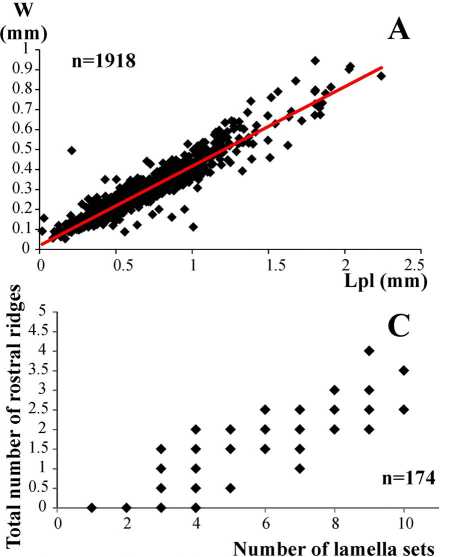
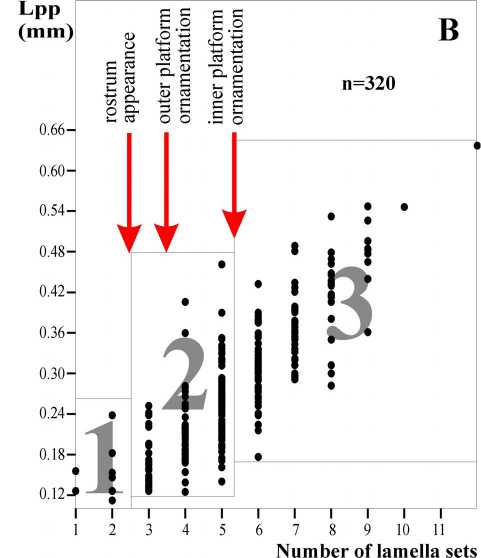
Fig. 2. Biometry of the Pa-elements of advanced Siphonodella : A — the platform length (Lpl) versus the platform width (W); B — structural changes in ontogeny of the advanced Siphonodella , grey numbers mark stage of ontogeny; C — changes of the number of rostral ridges in ontogeny of the advanced Siphonodella
Ðèñ. 2. Áèîìåòðèÿ Pa-ýëåìåíòîâ ðàçâèòûõ ïðåäñòàâèòåëåé ðîäà Siphonodella : A — ñîîòíîøåíèå äëèíû (Lpl) è øèðèíû (W) ïëàò-ôîðìû; B — ñòðóêòóðíûå èçìåíåíèÿ ðàçâèòûõ ïðåäñòàâèòåëåé ðîäà Siphonodella â îíòîãåíåçå, ñåðûìè öèôðàìè îòìå÷åíû ñòàäèè îíòîãåíåçà; Ñ — èçìåíåíèå êîëè÷åñòâà ðîñòðàëüíûõ ãðåáíåé â îíòîãåíåçå ðàçâèòûõ ñèôîíîäåëëèä
Results and discussion
The set of the observable taxonomic features varies significantly in dependence of ontogeny stage. The Pa-elements of the third stage demonstrate full set of morphological features, namely platform outline, ornamentation (nodes and costa), rostral ridges, morphology of aboral side (keel, basal pit), and curvature of carina. All the features in various combinations are used in the taxonomic diagnostics [8]. However not all the features can be observed in Pa-elements of early stages of ontogeny. So, determination of some species is impossible or difficult.
Several groups depending on the ontogeny complexity can be recognized in the advanced Siphonodella (Text table).
The first group comprises forms having simple ontogeny without significant structural modifications of Pa-element morphology. This group consists of S. duplicata , S. quasinuda , S. semichatovae M2, and S. lobata . Early appearance of the simple rostrum (up to 2 rostral ridges) and uniform platform outline in ontogeny are characteristic for the group. Rather thick platform is common as well. Platform asymmetry presents at all the ontogeny stages of S. semichatovae M2. Specific carina curvature and asymmetry of flanks of basal pit of S. lobata occur in different ontogenetic stages as well. The early forms of S. duplicata demonstrate presence of the rostrum and ornamentation of the platform (short costa). The early appearance of the rostrum is also specific for S. quasinuda , however this species has peculiar thick platform. Species of the group are easily determinable at all the ontogenetic stages (fig. 3).
The second group is composed by species with Pa-elements demonstrating similar platform outline at the early ontogenetic stages (excluding S. crenulata and S. belkai) combined with significant structural modifications in the ontogeny. Most prominent morphological modifications appeared in changes of number of rostral ridges, their length, and development of the platform sculpture.
The species having two rostral ridges at the third stage of ontogeny ( S. crenulata and S. hassi ) demonstrate late appearance of the rostrum (at late second stage of ontogeny), and characteristic convergence of rostral ridges, which is observable at rather early ontogenetic stages (see fig. 3). Early stages of Sipho-nodella crenulata have clear asymmetry of the platform outline, similar to S. semichatovae M2. S. hassi demonstrates convergence of the inner rostral ridge and carina associated with junction of the inner and outer rostrum with the blade at the same level already at the early second ontogenetic stage. However it is necessary to prove stability of these characters.
The species possessing more than two rostral ridges can be differentiated by length of outer adcarinal rostral ridge (fig. 4).
The long ridge appearing at the early ontogenetic stages as uplifting of the platform margin is characteristic for S. obsoleta , S. sandbergi , and S. belkai . The late two species have specific platform outline: lanceolate in S. sandbergi , and lenslike in S .belkai . S. obsoleta demonstrates clear asymmetry of the platform already at the earliest stage of ontogeny. So, platform outline can be used as key taxonomic feature for the juvenile forms.
The species having short rostral ridges ( S. quadruplicata , S. cooperi , and S. isosticha ) can’t be confidently separated at the earliest stage of ontogeny. Later ontogenetic stages having rostral ridges can be distinguished by form of the outer ridge and
The groups of advanced Siphonodella
Группы развитых представителей рода Siphonodella
|
Structural modification |
No structural modification |
||
|
more than 2 rostral ridges |
up to 2 rostral ridges |
up to 2 rostral ridges |
|
|
only short rostral ridges |
may have long rostral ridges |
S. crenulata |
5. duplicata |
|
S. quadruplicata |
S. obsolete |
S. quasinuda |
|
|
S. cooperi |
S. sandbergi |
S. semichatovae М2 |
|
|
S. hassi |
|||
|
S. isosticha |
S. belkai |
S. lobata (with rostral ridges) |
|
|
III class of symmetry |
II class of symmetry |
||
|
Stage of ■—-—ontogeny Taxon '— |
1 |
|
Siphonodella lobata |
|
|
Siphonodella crenulata |
|
|
Siphonodella duplicata |
9 |
|
Siphonodella semichatovae М2 |
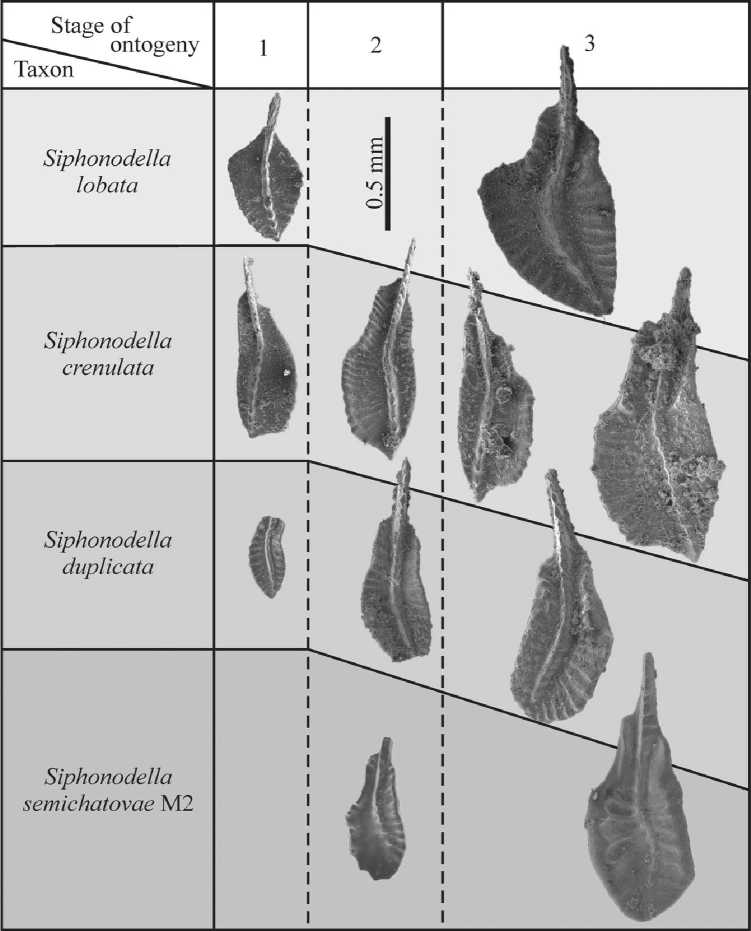
Fig. 3. Ontogenetic successions of the characteristic Siphonodella species possessing up to two rostral ridges
Рис. 3. Онтогенетические ряды характерных видов рода Siphonodella , имеющих не более двух ростральных гребней
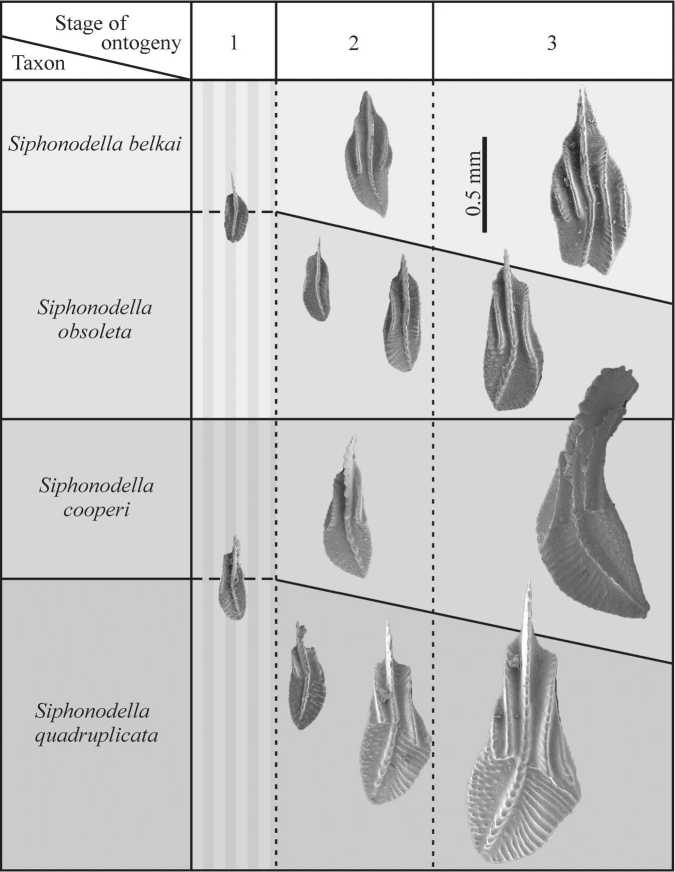
Fig. 4. Ontogenetic successions of the characteristic Siphonodella species possessing more than two rostral ridges at late stage of ontogeny. The vertical grey stripes mark ontogenetic stages, at which species can’t be confidently separated
Ðèñ. 4. Îíòîãåíåòè÷åñêèå ðÿäû õàðàêòåðíûõ âèäîâ ðîäà Siphonodella, èìåþùèõ áîëåå äâóõ ðîñòðàëüíûõ ãðåáíåé íà ïîçäíèõ ñòàäèÿõ. Âåðòèêàëüíûå ñåðûå ïîëîñû îòìå÷àþò îíòîãåíåòè÷åñêóþ ñòàäèþ, íà êîòîðîé óâåðåííàÿ äèàãíîñòèêà îòäåëüíûõ âèäîâ íåâîçìîæíà presence or absence of ribbing ornamentation of the outer platform. The straight outer rostral ridge is specific for S. quadruplicata, concave outer rostral ridge in association with smooth outer platform is characteristic for S. isosticha, concave outer rostral ridge in association with ribbed outer platform is specific for S. cooperi. Additionally, species of this group are similar to S. hassi at the first and second ontogenetic stages. The dextral elements of S. hassi are very similar to S. quadruplicata taking into account weak convergence of rostral ridges occurring in both the species. Preliminary data suggest that the rostrum symmetry may be reliable character for distinguishing of S. hassi and S. quadruplicata.
It is neccessary to note that name Siphonodella hassi Ji, 1985 is homonym of Siphonodella cooperi hassi Thompson et Fellows, 1970, additionally the new name proposed for this taxon (Siphonodella jii Becker, Kaiser et Aretz, 2016) is junior synonym of S. quadruplicata (Branson et Mehl) due to selection of the holotype, which is conspecific to S. quadruplicata [1]. The forms figured by W.H. Hass as S. duplicata var. A (see [4], pl. 49, fig. 17,18) and selected as holotype of S. jii (see [1]) rather represent ontogenetic stages of S. quadruplicata possessing more than two rostral ridges. So, the new name must be proposed for Siphonodella hassi Ji with conservation of the holotype proposed by Ji Qiang [5]. Provisionally the name Siphonodella hassi Ji is used here.
It is notable that siphonodells with two rostral ridges only demonstrate II class of symmetry, the others show features of III class of symmetry by Lane [7]. The II class of symmetry comprises asymmetric conodont elements exhibiting mirror-imaged pair of sinistral and dextral elements. The conodont elements of III class of symmetry illustrate absence of mirror-imaged symmetry of sinistral and dextral elements.
Conclusions
The advanced siphonodells can be distinguished at the early stages of ontogeny on the basis of rostrum morphology, platform outline, presence or absence of ribbing ornamentation of the outer platform. Siphonodella crenulata, S. duplicata, S. quasinuda, S. semichatovae M2, S. lobata are easily distinguishable at the earliest ontogenetic stage. The group possessing numerous long ridges can be differentiated at the species level just since the second stage of ontogeny. Siphonodells having more than two short rostral ridges and S.hassi can be reliably determined since the third stage of ontogeny as well.
The investigations were supported by the RAS (project ¹ 1518-5-37).
Acknowledgments
-
S. Shevchuk and V. Filipov helped to take the SEM images.The authors have benefited from discussion with Dr. Dmitry V. Ponomarev and anonymous reviewers.
Список литературы Морфология ранних стадий онтогенеза развитых представителей рода Siphonodella (конодонты, ранний карбон)
- Becker R. T., Kaiser S. I., Aretz M. Review of chrono-, litho- and biostratigraphy across the global Hangenberg Crisis and Devonian-Carboniferous Boundary // Becker, R. T., Konigshof, P. & Brett, C. E. (eds) Devonian Climate, Sea Level and Evolutionary Events. Geological Society, London, Special Publications, 423, 2016. DOI: 10.1144/SP423.10
- Boersma K. Th. On the basal structure of Siphonodella cooperi Hass, 1959 and Siphonodella lobata (Branson & Mehl), 1934. Leidse Geologische Mededelingen. Bd. 49. N. 1, 1973, pp. 39-57.
- Collinson C., Scott A. J., Rexroad C. B. Six charts showing biostratigraphic zones and correlations based on conodonts from the Devonian and Mississippian rocks of the upper Mississippi Valley. Illinois Geol. Survey Circ. V. 328. 1962. 32 p.
- Hass W. H. Conodonts from the Chappel Limestone of Texas. US Geological Survey Professional Paper 294-J, 1959, pp. 385-399.
- Ji Q. Study on the phylogeny, taxonomy, zonation and biofacies of Siphonodella (Conodonta). Bulletin of the Institute of Geology Chinese Academy of Geological Sciences, Vol. 11, 1985, pp. 51-78.

